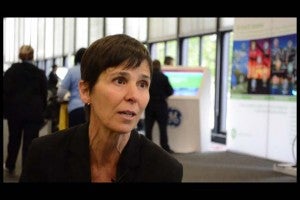This commentary was originally posted on the EDF Business Blog by Jason Mathers, EDF’s Corporate Partnerships Project Manager.
On the train back north from the U. S. Freight Sustainability Summit this past Friday, two thoughts kept circling around in my mind:
- First, the U. S. EPA SmartWay program has created a powerful coalition working on freight sustainability, and its efforts have produced significant benefits for the environment, economy and energy security.
- Second, the gulf in scale of action between where we are today and where we need to be is enormous.
Environmental Defense Fund (EDF), the American Trucking Associations (ATA) and the Retail Industry Leaders Association (RILA) co-hosted the freight summit.
Since its inception, EPA SmartWay has injected $6.1 billion dollars into the U. S. economy by reducing fuel consumption from the nation’s freight system– producing a heck of a return for the small investment that taxpayers have made into this program. In the process, it has cut over 16 million metric tons of carbon pollution. It’s a great start.
However, 16 million metric tons is a small percentage of the overall emissions attributed to the freight sector – over half-a-billion metric tons a year in the U. S. alone. And, as we heard again and again at the Freight Sustainability Summit, demand for goods movement is expected to grow significantly over the coming years. So, we simply need to do more.
There were many reasons for optimism at the summit. Top among these is the collective focus of industry, advocacy groups and government agencies on working collaboratively to further this effort. There is universal recognition that we must radically increase the efficiency of freight movement in order to meet the challenge of increasing levels of freight demand while still facing a tighter fuel market, an aging and overextend infrastructure and an environmental mandate to cut carbon.
We also heard scores of success stories from some of the largest and most sophisticated companies in the world. Lowes has reduced a million tons of carbon already from its fleet. Conway told the group how it cut fuel consumption by six million gallons simply by reducing the top speed for its trucks (now 62mph for less-than-truck load and 65mph for truckload applications). Swift shared some impressive results from its pilot of a new aerodynamic fairing that is bolted on underneath a trailer. Michelin told us about real-world studies demonstrating a 9% improvement in fuel economy for tractor-trailer combinations that use new generation wide base tires. My personal favorite was from Home Depot, which was able to cut its domestic supply chain freight emission by 13% in one year – largely from operational improvements.
It’s not just the Fortune 500 group of companies that are acting. Smaller companies shared their stories too. Vic LaRosa, the president of Total Transportation Services, spoke about how his company is helping reduce air pollution around some of the nation’s busiest ports by leveraging alternative fuels and advance vehicle technologies. Several speakers mentioned how small firms and owner-operators will benefit from increases in truck fuel efficiency.
These stories and other sparked by the leadership of the EPA SmartWay program make very good business sense too. Walmart alone has cut its fuel costs by half-a-billion dollars a year since 2005 from improved logistics.
Clearly, progress is being made and more – much more – is possible.
Consider for a second that—based on the SmartWay data points of $6.1 billion saved and 16 million metric tons carbon reduced – the average cost of a ton of carbon reduced under this program is negative $381. That is every ton reduced was accompanied by a nearly $400 dollar savings for the company. We’re not dealing with the low-hanging fruit of cutting freight emissions. We are largely dealing with the apples already on the ground.
Given these massive cost savings still available and the fact that the best science tells us that we need to cut our emissions on the order of 80% over the next 40 years, it is imperative to move freight sustainability well beyond 16 million metric tons that the program has achieved over seven years in fact, we need five to six times these reductions each year going forward.
How do we do this?
First and foremost, we need the EPA SmartWay to remain a strong program. Given its track record of financial returns for society and the urgency of the freight sustainability challenges we face, the program, frankly, should be greatly expanded. SmartWay provides incredibly useful forums for sharing lessons learned. This new generation of tools are performance-based; they enable shippers to track and manage their emissions footprint, while giving carriers a platform where they can compete on environmental performance. Companies that use the services of this vital program should make sure policymakers understand the value it provides.
Next, shippers – the companies that consumer goods movement services – need to step up to the plate and join the program in much larger numbers. As they are the primary customers in the freight economy, shippers play a critical role in rewarding superior environmental performance of carriers. If your company purchases goods movement services and you are not sure if it is a member of SmartWay, you can check here. If it turns out that your company has been on the sidelines of this effort, you can join SmartWay here.
We all need to redouble effort to share lessons learned. As Randy Mullet if Conway noted, like safety and security, companies should freely share their advancements on sustainability. The journey is too long and the challenge too steep for all of us to have to figure out the answers individually
Finally, the freight community needs to aim higher. Significant progress has been made over the last seven years of the SmartWay program. The buy-in from diverse stakeholders, case studies from partners and new generation of tools has created a foundation upon which we all need to build a new freight future; one that measures success against an ever larger scale.















